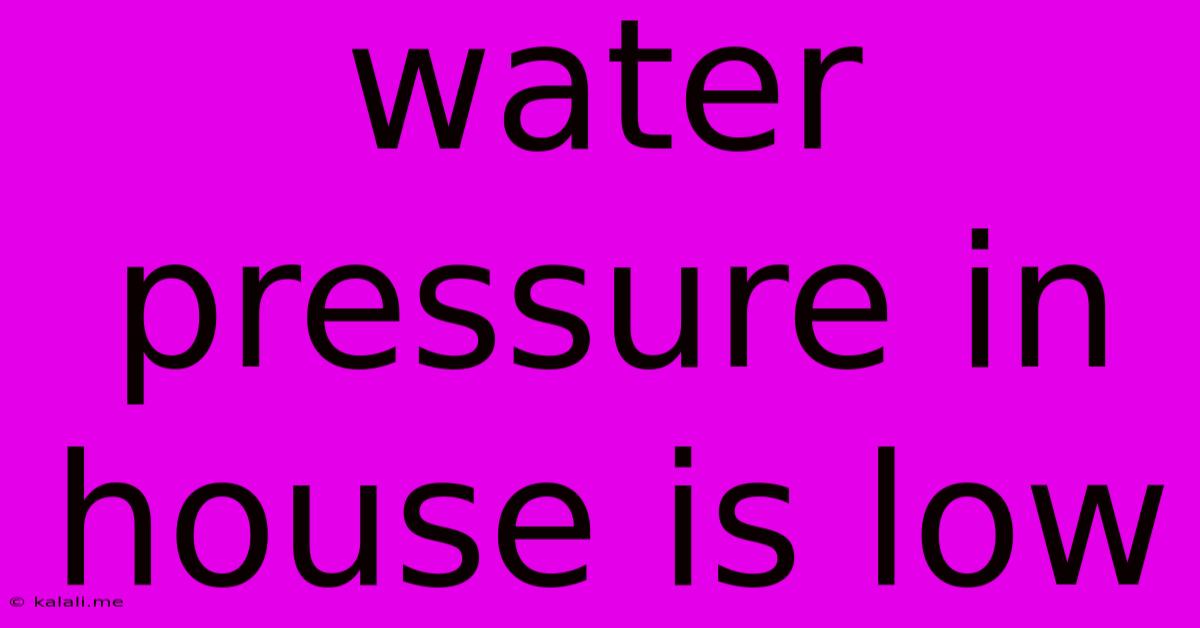Water Pressure In House Is Low
Kalali
Jun 05, 2025 · 4 min read

Table of Contents
Low Water Pressure in Your House: Troubleshooting and Solutions
Low water pressure is a frustrating problem that can disrupt daily routines and impact household appliances. This article explores common causes of low water pressure in your home, providing practical troubleshooting steps and potential solutions to get your water flowing at full strength again. Understanding the root cause is key to resolving the issue effectively.
Why is my water pressure low? Several factors can contribute to reduced water pressure, ranging from simple fixes to more complex plumbing issues. Identifying the source will determine the best course of action.
Common Causes of Low Water Pressure
-
Main Water Line Issues: The problem might originate from the city's water main or your home's connection. Reduced water pressure throughout the entire neighborhood suggests a municipal problem. Contact your local water utility to report the issue. A leak or blockage in your main water line, however, is a problem specific to your property and requires professional attention.
-
Clogged Pipes: Mineral deposits, rust, or sediment buildup within your pipes can restrict water flow. This is more common in older homes with galvanized pipes. Over time, these deposits significantly reduce the internal diameter of the pipes, impeding water pressure.
-
Faulty Water Meter: A malfunctioning water meter can restrict water flow into your home. Check the meter for any obvious obstructions or signs of damage. If you suspect a problem with the meter, contact your water utility company.
-
Leaking Pipes: Internal leaks within your plumbing system can significantly lower the overall water pressure. These leaks are often difficult to detect visually but may manifest as unusually high water bills or damp spots in walls or floors.
-
Pressure Regulator Issues: The pressure regulator, often located near your main water line, controls the water pressure entering your home. A faulty or incorrectly adjusted regulator can lead to low water pressure.
-
Air in the Lines: Air trapped within your plumbing system can disrupt water flow and cause pressure fluctuations. This is often noticeable as a gurgling sound from the pipes.
-
Restricted Faucets and Fixtures: Mineral deposits or debris can accumulate within faucet aerators, showerheads, and other fixtures, causing restricted water flow. Cleaning or replacing these components can often resolve the problem.
Troubleshooting Steps: Identifying the Source of Low Water Pressure
Before calling a plumber, try these simple troubleshooting steps:
-
Check Multiple Faucets: Does the low pressure affect all faucets and fixtures, or only some? If it's widespread, the problem likely lies within the main water supply or internal plumbing. If it's localized, the issue might be with a specific fixture.
-
Check Your Water Meter: Observe your water meter during periods of high water usage (e.g., running a shower). If the meter isn't moving as expected, there could be a problem with the meter or main water line.
-
Examine Faucet Aerators and Showerheads: Remove and clean the aerators and showerheads to remove any buildup that might be obstructing water flow. Sometimes, a simple cleaning is all that's needed.
-
Listen for Unusual Noises: Pay attention to any gurgling or unusual sounds coming from your pipes. These sounds may indicate air in the lines or a leak.
Solutions for Low Water Pressure
The solution depends entirely on the cause of the problem. Some solutions, like cleaning aerators, are DIY projects. Others, such as repairing leaking pipes or replacing the main water line, require the expertise of a qualified plumber. Consider these options:
-
Cleaning Fixtures: This is the easiest fix, often involving removing and cleaning aerators or showerheads.
-
Professional Plumbing Inspection: If you suspect a leak, blockage, or other internal plumbing issue, it's essential to call a licensed plumber for a thorough inspection and repair.
-
Pressure Regulator Adjustment or Replacement: If the pressure regulator is the culprit, it might need adjustment or replacement. This is best left to a qualified plumber.
-
Water Line Replacement: In cases of significant damage or deterioration to the main water line, replacement might be necessary. This is a major undertaking requiring professional expertise.
Addressing low water pressure promptly is crucial to prevent further damage and ensure the efficient functioning of your household plumbing system. Remember to prioritize safety and call a qualified professional if you are unsure about any repair or troubleshooting steps. Don't hesitate to contact your local water utility if you suspect a problem with the municipal water supply.
Latest Posts
Latest Posts
-
Ac Not Keeping Up With Thermostat
Jun 06, 2025
-
Does Magnesium Have A Low Melting Point
Jun 06, 2025
-
Enterprise Car Rental Do I Need To Clean The Car
Jun 06, 2025
-
Can You Eat Brussels Sprouts Raw
Jun 06, 2025
-
Gas Station With Microwave Near Me
Jun 06, 2025
Related Post
Thank you for visiting our website which covers about Water Pressure In House Is Low . We hope the information provided has been useful to you. Feel free to contact us if you have any questions or need further assistance. See you next time and don't miss to bookmark.